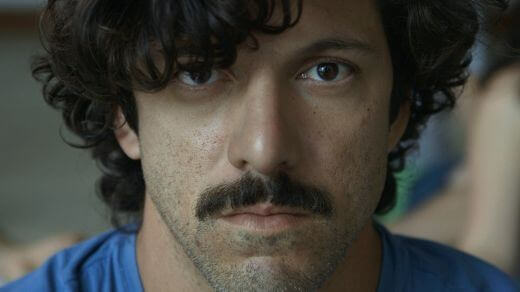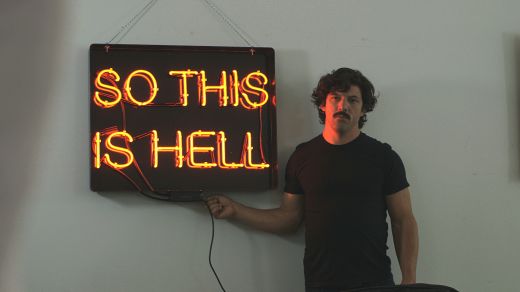- Stadium and Museum: Herzog & de Meuron’s Architecture of Participation

- Deborah Kass, Double Yentl (My Elvis) Global Positioning Systems
Miami Rides to Sundance on the Pegs of The Strongest Man
Cherry Pickman

Still from The Strongest Man, 2015
That Miami is different from every other American city is not revelatory; even in its stereotypes it stands apart from any familiar bit of Americana. But The Strongest Man, while certainly recognizing the excesses Miami has long been known for, offers a more nuanced and accurate (not to mention beautiful) portrait of what Miami looks like through the eyes of a young artist. That young artist is Beef (played by Lorie). Though Lorie has no formal training as an actor, he handles the lead with aplomb—a testament to Riches’s writing and casting. Beef is a captivating, if taciturn character, and is the perfect vessel to offer a unique and intimate depiction of the place to which he is inextricably tied.
One of the opening scenes shows a building being demolished; the Jacuzzi Boys’ “Planet of the Dreamers” plays over the opening credits and Gabriel Alcala sings “my dreams are dead.” This might seem like the perfect beginning to any angsty indie film, but the song is noticeably up-tempo and fun, and the reel quickly rewinds to reveal the building intact. The scene, maybe thirty seconds in total, is the perfect introduction to the film’s dichotomous approach. The Strongest Man toggles between reality and fantasy, strong facades and insecure interior worlds, profound moments and instances of pure silliness and levity.
Beef is the strongest man in the world. He can run through concrete walls. He rides a gold BMX. He can lift at least twice as much as the average man, but he’s beset by anxiety. Throughout the movie, his inner monologue is in Spanish and his spoken dialogue is in English. While this might seem natural to native Spanish speakers, it also acts as a device to delineate between Beef’s internal and external worlds and to illustrate how vast the differences are between them.
He and his hapless best friend Conan (played by Paul Chamberlain) work construction and go on adventures of self-discovery together. After attending a meditation class led by the comically German-accented Guru Fred (Patrick Fugit of Almost Famous), they begin a misguided search for their spirit animals. Beef’s is a chicken (the perfect foil for the strongest man) and Conan’s is a dog (perhaps a nod to his loyalty as a friend). During their quest, which, as it progresses, takes a very literal form—they set out to find an actual dog and an actual chicken—things go wrong. Beef accidentally kills his chicken, Conan loses his dog, and Beef’s beloved bike gets stolen, which consequently complicates their pursuits. They set out on a new quest—to recover the bike.
Meanwhile, the tedium of life continues around them. Beef has a side job moving art for Mrs. Rosen, a brutally snobbish woman in her midfifties played by Lisa Banes. There he meets Mrs. Rosen’s niece Illi (Ashly Burch) and they form a mutual crush. Mrs. Rosen serves as a hyperbolic representation of Miami’s elite art-world crowd, and some of the film’s funniest moments come from scenes in her apartment, which were shot in the Rubell family home. Many of the works featured are by Miami artists and friends of Riches, which makes the pointed visual jokes all the more delightful. It’s as if Riches is saying that in order to love Miami, you’ve got to be able to laugh at its ridiculousness. And there’s plenty to laugh about: a painting of a dog taking a shit is the focal piece in Mrs. Rosen’s living room. But only for a while, until a red neon sign that reads “SO THIS IS HELL” takes its place.
And sometimes it appears that Mrs. Rosen’s place—a luxury high-rise coincidentally right across the street from Beef’s spare, ground-level apartment—is symptomatic of a larger figurative hell for all the film’s characters. Mrs. Rosen is surrounded by wealth and devoid of any meaningful relationships, her niece Illi seems to be simultaneously trapped in the comforts of her aunt’s world and pulled to the more meaningful, but less comfortable “real” world; Conan struggles to find his own identity in the shadow of his over-achieving brother and alienated immigrant parents; and Beef, who is able to break down any physical barrier, seems unable to get out of his own way enough to have a romantic relationship with Illi.
But in The Strongest Man, the disjointedness of the lives of its characters and of the city itself doesn’t always equate to discord. In fact, sometimes it produces the most beautiful and poignant moments in the film. When Illi and Beef try to communicate via string-and-tin-can telephone and it doesn’t work, Beef falls into a daydream soliloquy in Spanish in which he spills out his feelings for Illi, revealing him at his most vulnerable and most earnest. Likewise, the moments of indecision when Conan asks Beef what the one sound is that he’d want to hear if he could hear just one sound for the rest of his life, or when Beef asks Conan what would be the one thing he’d like to see if he could only see one thing for the rest of his life: they can’t decide. There are too many choices. And that’s okay. Wherever they are in their lives, they’re in the right place—a place that has as much glitz as it has natural beauty. They pick mangoes from a public park. They watch the bay turn pink from the side of the highway.










